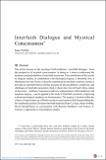Interfaith Dialogue and Mystical Consciousness
Abstract
This article focuses on the meeting of faith traditions—interfaith dialogue—from the perspective of mystical consciousness. In doing so, it aims to understand the dynamics and potentialities of interfaith mysticism. The contribution of this article to religious studies, in combination with theological inquiry, is threefold: first, it illuminates how the Trinity is directly experienced in interfaith contexts; second, it provides an interfaith framework which accounts for the possibilities, complexity, and challenges of interfaith encounters; third, it shows how Gavin Flood’s three orders of discourse—traditions’ experience and texts, interpretation within traditions, and academic inquiry—can be applied to the study of interfaith mysticism, employing a phenomenological emphasis on hermeneutics. The inquiry is located within the context of representatives of Hindu mystical consciousness (Sri Ramana Maharshi, Sri Aurobindo) and the Christian interfaith tradition (Le Saux, Griffiths, Steindl-Rast), in conversation with Raimon Panikkar’s and Francis X. Clooney’s approaches to inter-religious studies.
Citation
Portilla , I 2022 , ' Interfaith Dialogue and Mystical Consciousness ' , Harvard Theological Review , vol. 115 , no. 4 , pp. 591–620 . https://doi.org/10.1017/S0017816022000335
Publication
Harvard Theological Review
Status
Peer reviewed
ISSN
0017-8160Type
Journal article
Collections
Items in the St Andrews Research Repository are protected by copyright, with all rights reserved, unless otherwise indicated.

